Preferred temperature (Ref.
115969): -0.8 - 5, mean 1 (based on 340 cells).
Phylogenetic diversity index (Ref.
82804): PD
50 = 0.5010 [Uniqueness, from 0.5 = low to 2.0 = high].
Bayesian length-weight: a=0.00316 (0.00272 - 0.00368), b=3.25 (3.21 - 3.29), in cm Total Length, based on LWR estimates for this species (Ref.
93245).
Nivel trófico (Ref.
69278): 4.2 ±0.3 se; based on diet studies.
Resiliencia (Ref.
120179): Bajo, población duplicada en un tiempo mínimo de 4.5-14 años (K=0.17; tm=4; Fec=13-20).
Prior r = 0.09, 95% CL = 0.06 - 0.13, Based on 1 full stock assessment.
Fishing Vulnerability (Ref.
59153): Moderate to high vulnerability (51 of 100).
